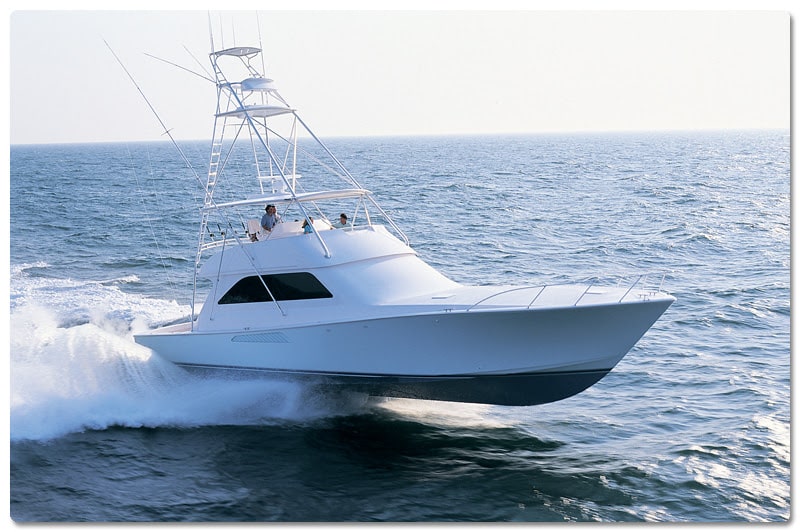
If you have not yet seen the new Viking 61 Convertible, don’t fret. Your wait won’t be long. With more than 55 orders logged since her introduction in the fall of 1999, the 61 is a prominent feature on Viking’s production line.
Bill Healey, Viking’s patriarch, deserves credit for the successful launch. When other builders were pulling in their horns during the last down cycle, Healey was investing in new design and tooling in anticipation of a strengthening market. As a result, Viking has introduced 13 new products during the past seven years. The 61, like her sister, the 55, should help reinforce Viking’s prominent position as a builder of production convertibles and open models that reflect popular trends in custom fish boats. The 61’s crisp performance, clean profile and generous appointments are all-American, with no hint of changes some other U.S. builders have made to broaden appeal in the cruising-based international market.
There’s a clear view of the cockpit from the tournament-style helm control pod, and a clever notched windscreen design improves visibility across the foredeck. Side-mounted, single-lever controls and power-assisted hydraulic steering deliver pinpoint accuracy to make charging through an inlet or backing down on a blue marlin a snap. Electronics are built into the curved console and protected by hinged, acrylic doors. Fore and aft bench seating is to starboard, and an L-shape settee is forward of the helm-both with space beneath for rod stowage. The bridge console also includes a built-in chill box and accommodates an optional top-loading freezer.
A new hidden mounting system (no exposed screws) for sub-moldings, such as the console, enhances the bridge’s clean appearance. Our test boat was rigged for fishing with Rupp outriggers and a PipeWelders tower. Viking offers a fiberglass hardtop with isinglass, or a fully enclosed bridge with a helm-forward design and interior access. Our test boat had an optional abbreviated tournament-style bow rail; with this configuration, I recommend adding grab rails on the house face corners.
The 61’s 170-square-foot cockpit is uncluttered and businesslike. A freezer, a drink box, a tackle center, a sink and engineroom access are hidden neatly in the molded-in bulkhead console. A 53-by-20-by-20-inch fish/stowage box is recessed in the sole and flanked by twin stowage wells that can be converted to live wells. Fresh- and saltwater washdowns are fitted, and Glendinning Cablemasters (port and starboard) allow easy shoreside hookups without snaking shore cords about the cockpit.
While the 61’s styling and exterior are groomed to tournament standards, her interior layout is generous compared with many custom offerings. This is in part because of the volume afforded by her 18-foot, 2-inch beam and her moderate forward sections. This is typical for Viking, whose design approach favors interior accommodations and respectable head-sea performance. In fact, the 61’s arrangement is similar to that on the 55. The open galley layout has under-counter, Sub-Zero, drawer-style refrigeration and space for an optional trash compactor or dishwasher. The 55’s saloon is hard to improve upon, but Viking used the 61’s additional volume for a U-shape sofa and a slightly roomier dinette.
Belowdecks, the arrangement is also similar to that on the 55, with the 61’s biggest gains in the master stateroom. It has a king-size berth and a cross-bulkhead hanging locker that’s thoughtfully positioned to shield sound from the machinery space. The standard three stateroom/three head arrangement would be my choice. An optional forward stateroom layout has an island queen instead of a crossed-berth arrangement.
The 61 is available with teak finish and a number of interior décor packages. An $8,340 Luxury Edition package includes upgrades such as sculptured carpet and leather upholstery.
Her molded fiberglass hull is laminated with a blend of knitted multidirectional reinforcement, polyester resin and a modified epoxy skin coat. Balsa coring is hand applied in the topsides and vacuum-bagged in the bottom. Viking has had success coring the bottoms of its 65-foot and 72-foot convertibles and believes the weight savings found and stiffness gained are necessary for performance. Coring is substituted for additional reinforcement in way of the through-hulls, and at the keel and chines. The hull is supported with cored fiberglass bulkheads and a network of fiberglass stringers. The superstructure and deckhouse are molded in one piece, and coring stiffens the decks and house sides.
As is typical from Viking, the 61’s engines are mounted on steel I-beams that span the engineroom and are fastened to the bulkheads, in an effort to transmit engine weight and thrust more evenly to the hull. Fiberglass tanks, molded separately from the hull, carry a total of 1,800 gallons of fuel. An additional 200 gallons of tankage can be added.
Standing headroom in the 61’s engineroom is a delight. Sea chests and auxiliary systems are segregated in an adjacent machinery compartment forward. To reduce clutter, bulky internal seawater strainers are replaced with wedge-style external strainers. I am not wild about this arrangement because in some waters, external strainers can foul quickly. A single 20kW generator with a sound shield is standard, positioned abaft the engines. An additional 20kW generator can be added, and I recommend the investment for those planning on wandering.
The 61 not only looks the part, she raises fish. Hull number one placed first in the blue marlin category in the 27th White Marlin Open in Ocean City, Maryland. Her base price of $1,785,000 with 1,300 hp MANs is competitive with other production designs and a bargain compared with some custom tournament boats.
Contact: Viking Yacht Company, (609) 296-6000; fax (609) 296-3956; www.vikingyachts.com.








